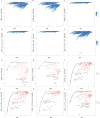Global, regional and national burden of injuries caused by fire, heat, and hot substances from 1990 to 2021
- PMID: 40392861
- PMCID: PMC12091820
- DOI: 10.1371/journal.pone.0324481
Global, regional and national burden of injuries caused by fire, heat, and hot substances from 1990 to 2021
Abstract
Background: Burn injuries, which are caused by fire, heat, and hot substances, are considered a chronic condition due to their long-term effects on the health of affected individuals. Moreover, burn injuries constitute a significant public health issue that cannot be overlooked within the global healthcare system.
Materials and methods: This study comprehensively analyzed the burden of burn injuries, focusing on variations by Socio-Demographic Index (SDI) levels and Global Burden of Disease (GBD) regions, sex-based disparities, Frontier analysis, and future trend forecasting using the Bayesian Age-Period-Cohort (BAPC) model.
Results: Compared to 1990, the global burden of burn injuries decreased in most regions worldwide in 2021. The majority of regions showed a negative Estimated Annual Percentage Change (EAPC), indicating a continuous decline in Age-Standardized Rate (ASR) annually. And the ASR decreased with the increasing SDI. Moreover, the forecasted trend from 2021 to 2030, indicates a continued decline with a well-fitted projection model.
Conclusions: Despite the observed and projected decline in global ASR of burn, the burden of burn remains a significant concern that should not be underestimated.
Copyright: © 2025 Huang et al. This is an open access article distributed under the terms of the Creative Commons Attribution License, which permits unrestricted use, distribution, and reproduction in any medium, provided the original author and source are credited.
Conflict of interest statement
The authors have declared that no competing interests exist.
Figures




Similar articles
-
The global, regional, and national burden of burns: An analysis of injury by fire, heat, and hot substances in the global burden of disease study 2019.Injury. 2025 Jan;56(1):111955. doi: 10.1016/j.injury.2024.111955. Epub 2024 Oct 15. Injury. 2025. PMID: 39443227
-
Trends and cross-country inequalities in global burns burden among children and adolescents: A population-based study from 1990 to 2021.Burns. 2025 Apr;51(3):107377. doi: 10.1016/j.burns.2025.107377. Epub 2025 Jan 9. Burns. 2025. PMID: 39848116
-
Global, regional and national trends in the burden of low bone mineral density from 1990 to 2030: A Bayesian age-period-cohort modeling study.Bone. 2024 Dec;189:117253. doi: 10.1016/j.bone.2024.117253. Epub 2024 Sep 7. Bone. 2024. PMID: 39245331
-
Global, regional, and national burden of asthma and atopic dermatitis, 1990-2021, and projections to 2050: a systematic analysis of the Global Burden of Disease Study 2021.Lancet Respir Med. 2025 May;13(5):425-446. doi: 10.1016/S2213-2600(25)00003-7. Epub 2025 Mar 24. Lancet Respir Med. 2025. PMID: 40147466
-
Global burden of myocarditis in youth and middle age (1990-2019): A systematic analysis of the disease burden and thirty-year forecast.Curr Probl Cardiol. 2024 Sep;49(9):102735. doi: 10.1016/j.cpcardiol.2024.102735. Epub 2024 Jun 29. Curr Probl Cardiol. 2024. PMID: 38950720 Review.
References
-
- James SL, Lucchesi LR, Bisignano C, Castle CD, Dingels ZV, Fox JT, et al.. Epidemiology of injuries from fire, heat and hot substances: global, regional and national morbidity and mortality estimates from the Global Burden of Disease 2017 study. Inj Prev. 2020;26(Supp 1):i36–45. doi: 10.1136/injuryprev-2019-043299 - DOI - PMC - PubMed
MeSH terms
LinkOut - more resources
Full Text Sources
Medical

